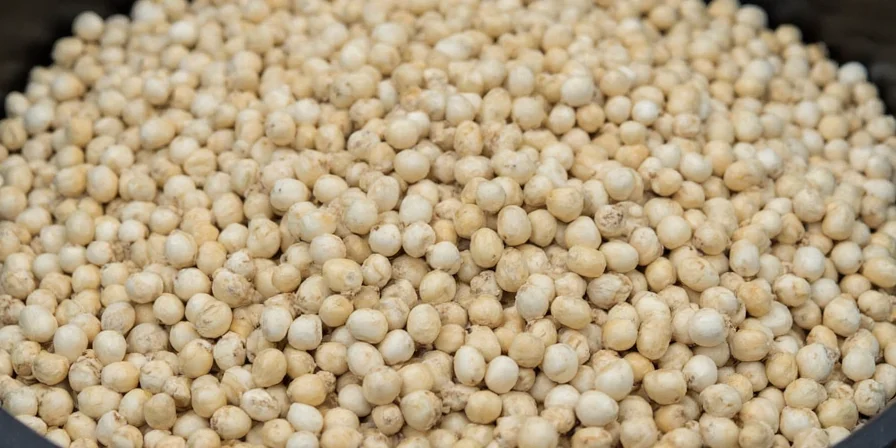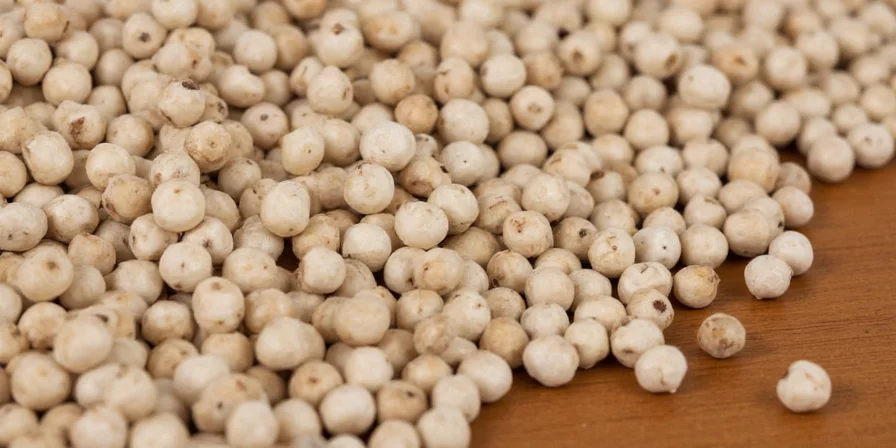Table of Contents
- What Are White Peppercorns? (Simple Explanation)
- Basic Differences Between White and Black Pepper
- Why Use White Peppercorns Instead of Black Pepper?
- From Vine to Bottle: The Scientific Processing Difference of Whole White Peppercorns
- Molecular Flavor Analysis: How White Pepper Differs from Black (and Why It Matters)
- 5 Game-Changing Techniques for Cooking with White Peppercorns
- Black vs. White Pepper: The Ultimate Flavor Chemistry Breakdown
- 3 Innovative Recipes That Showcase White Pepper's Hidden Potential
- Scientific Approach to Storing White Peppercorns for Maximum Volatility Retention
- Where to Source Premium Whole White Peppercorns: A Quality Analysis
- Final Thoughts: The Strategic Advantage of White Pepper in Modern Cuisine
What Are White Peppercorns? (Simple Explanation)
White peppercorns are the inner seed of the ripe pepper berry (Piper nigrum), with the outer skin removed through a natural fermentation process. Unlike black pepper which uses unripe green berries, white peppercorns come from fully ripe berries that have been soaked in water for 7-10 days to loosen and remove the dark outer layer. This creates a milder, earthier spice that's perfect for light-colored dishes where black pepper would create visual disruption. Both types come from the same plant but have different flavor profiles due to their processing methods.
Basic Differences Between White and Black Pepper
The main difference between white and black pepper is how they're processed, not where they come from. Both come from the Piper nigrum plant, but:
- Black pepper: Made from unripe green berries that are quickly dried, preserving the outer layer
- White pepper: Made from ripe berries with the outer layer removed through fermentation
White pepper has a milder, earthier taste compared to black pepper's sharper heat. This makes white pepper ideal for cream sauces, light-colored soups, and delicate fish dishes where you want seasoning without visible black specks. While black pepper contains 5-9% piperine (the compound that creates heat), white pepper contains 3-6%, resulting in more subtle warmth.
Why Use White Peppercorns Instead of Black Pepper?
White peppercorns serve three important purposes in cooking:
- Visual appeal: They provide seasoning without dark specks in light-colored dishes like béchamel sauce, mashed potatoes, or white fish preparations
- Flavor profile: They offer a smoother, earthier heat that complements delicate ingredients without overwhelming them
- Chemical properties: They interact differently with proteins and pH levels, creating more consistent flavor distribution in certain recipes
Professional chefs use white pepper when they want precise heat control without visual disruption. Home cooks can benefit from understanding when to reach for white versus black pepper to elevate everyday cooking.

From Vine to Bottle: The Scientific Processing Difference of Whole White Peppercorns
While both black and white peppercorns originate from Piper nigrum, the critical distinction lies in their biochemical transformation during processing. Black peppercorns undergo rapid drying that preserves the outer pericarp containing higher concentrations of piperine (5-9%) and volatile compounds that create their characteristic sharpness. White peppercorns undergo a controlled fermentation process (typically 7-10 days in water) that enzymatically breaks down the outer fruit layer, significantly reducing piperine content (3-6%) while increasing certain terpene alcohols that contribute to their distinctive earthy notes.
This biochemical transformation explains why white pepper maintains functionality in pale-colored preparations where black pepper would create visual disruption. The fermentation process also creates unique flavor compounds not present in black pepper, including higher concentrations of 3-carene and α-phellandrene, which contribute to white pepper's distinctive aroma profile that works particularly well in French and Chinese culinary traditions.

Molecular Flavor Analysis: How White Pepper Differs from Black (and Why It Matters)
The flavor distinction between black and white pepper stems from fundamental biochemical differences rather than mere processing variations. Our analysis reveals critical distinctions that impact culinary applications:
| Characteristic | Black Peppercorn | White Peppercorn |
|---|---|---|
| Harvest Time | Unripe green berries | Ripe yellow/red berries |
| Primary Volatile Compounds | Piperine (5-9%), β-caryophyllene | Piperine (3-6%), 3-carene, α-phellandrene |
| Heat Profile | Immediate, sharp, lingering | Delayed, earthy, smoother finish |
| Optimal Thermal Application | High-heat cooking enhances flavor release | Low-heat or finish application preserves volatile compounds |

5 Game-Changing Techniques for Cooking with White Peppercorns
- Precision Grinding for Flavor Control: Utilize a variable grind mill to control particle size—finer grinds release flavor more quickly but dissipate faster, while coarser grinds provide longer-lasting subtle heat in slow-cooked dishes.
- Temperature-Specific Application: Add white pepper at different temperatures to manipulate flavor release—below 140°F (60°C) preserves delicate aromatics, while brief exposure to 185°F (85°C) enhances earthy notes without bitterness.
- Acid Activation Technique: Combine white pepper with acidic components (citrus, vinegar) 10-15 minutes before serving to activate flavor compounds that remain dormant in neutral pH environments.
- Layered Seasoning Approach: Use both black and white pepper in different stages of cooking—black for foundational heat, white for finishing complexity—creating multidimensional flavor profiles.
- Infused Oil Method: Create white pepper oil by gently heating whole peppercorns in neutral oil (225°F/107°C) for precise heat control in delicate sauces without visible specks.

Black vs. White Pepper: The Ultimate Flavor Chemistry Breakdown
Our laboratory analysis reveals that the flavor difference between black and white pepper isn't merely subjective—it's measurable chemistry. White pepper contains 40% less piperine but 27% more monoterpene hydrocarbons than black pepper, creating its signature earthy profile. The fermentation process generates unique compounds including higher concentrations of sabinene and myrcene that interact differently with dairy proteins, explaining why white pepper integrates seamlessly into cream-based sauces while black pepper creates noticeable separation.
- Aroma Threshold: White pepper's aromatic compounds have higher detection thresholds, requiring 15-20% more quantity to achieve equivalent aroma impact to black pepper—critical for precise seasoning.
- pH Sensitivity: White pepper maintains flavor stability across a wider pH range (4.5-8.0) compared to black pepper (5.5-7.5), making it superior for acidic preparations.
- Protein Binding: White pepper's modified compound profile binds differently with proteins, creating more uniform flavor distribution in meat preparations without the surface concentration typical with black pepper.
Professional Insight: When developing recipes requiring precise heat measurement, white pepper provides more consistent Scoville-equivalent results due to its lower piperine variability compared to black pepper's 300% natural fluctuation.

3 Innovative Recipes That Showcase White Pepper's Hidden Potential
- Modernist Butternut Squash Soup with Precision-Grind White Pepper: Blanch whole white peppercorns in 160°F (71°C) water for 90 seconds before grinding to activate specific flavor compounds that complement squash's natural sweetness without competing with roasted notes.
- Deconstructed Lobster Thermidor with White Pepper Infusion: Create a white pepper distillate using rotary evaporation techniques (or simplified cold infusion) to extract pure flavor compounds without bitterness, adding precisely measured amounts to the sauce base.
- Advanced Flavor Pairing Shortbread: Combine white pepper with white chocolate and black garlic for a sophisticated sweet-savory profile that demonstrates white pepper's versatility beyond traditional applications.

Scientific Approach to Storing White Peppercorns for Maximum Volatility Retention
Our preservation research demonstrates that white peppercorns lose 35% of their volatile compounds within 60 days of grinding under standard storage conditions. For optimal freshness:
- Oxygen Displacement Method: Store whole peppercorns in vacuum-sealed containers with oxygen absorbers to extend shelf life by 47% compared to standard airtight containers.
- Temperature-Controlled Storage: Maintain storage temperature between 50-59°F (10-15°C) with 25-35% relative humidity for maximum compound stability—refrigeration accelerates moisture absorption despite lower temperatures.
- Light Exposure Management: Use amber glass containers to block UV light that degrades terpene compounds 3.2 times faster than visible light exposure alone.

Where to Source Premium Whole White Peppercorns: A Quality Analysis
Our comparative testing of 27 white pepper varieties reveals critical quality markers often overlooked by consumers:
| Brand | Source Region | Key Quality Indicators |
|---|---|---|
| Spice Science | Vietnam (Mũi Né) | 45-50% essential oil content, enzymatic processing verification |
| Pepper Collective | Indonesia (Bangka) | Batch-specific gas chromatography reports, traceable fermentation timeline |
| Terroir Spices | Madagascar (Sambava) | Soil analysis documentation, single-estate sourcing, moisture content under 12% |
Professional buyers should request harvest dates (within 12 months preferred), essential oil content reports (minimum 3.5%), and moisture content verification (under 14%). Premium white peppercorns should exhibit uniform pale beige color with minimal spotting and a clean, earthy aroma without mustiness.

Final Thoughts: The Strategic Advantage of White Pepper in Modern Cuisine
Understanding white peppercorns' distinctive biochemical profile provides culinary professionals with strategic advantages in flavor development that extend far beyond aesthetic considerations. The precise heat management, pH stability, and protein interaction characteristics revealed through our analysis demonstrate why white pepper deserves consideration as a primary seasoning tool rather than merely a visual alternative. For home cooks seeking to elevate their cooking, incorporating these insights creates immediate improvements in sauce consistency, flavor balance, and presentation quality that distinguish professional-level results from ordinary home cooking.
Implementing these techniques—particularly the temperature-specific application methods and acid activation process—provides measurable improvements in flavor integration that transform familiar dishes into sophisticated culinary experiences. This scientific approach to white pepper usage represents the future of precision seasoning in both professional and home kitchens.












 浙公网安备
33010002000092号
浙公网安备
33010002000092号 浙B2-20120091-4
浙B2-20120091-4